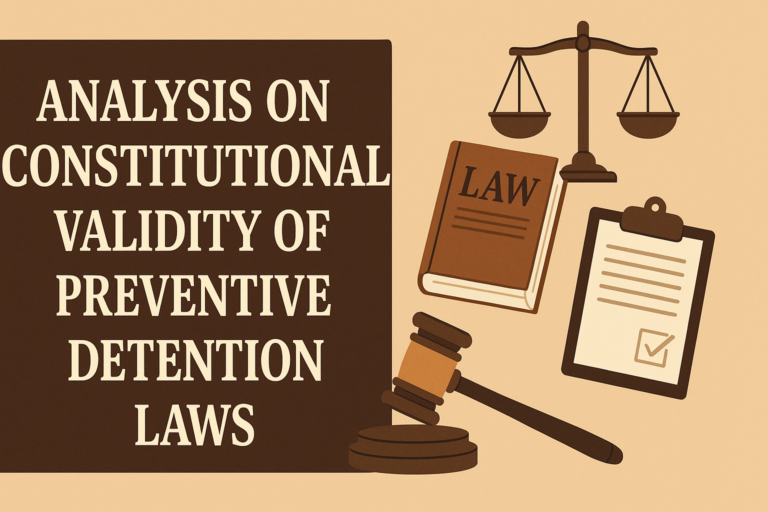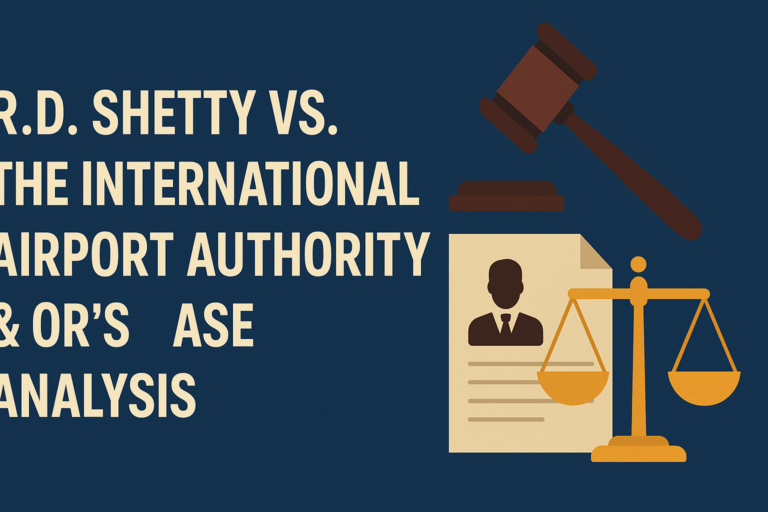This article has been written by Ananya Shruti, First-year BBA. LL.B student, Symbiosis Law School, Hyderabad.
ABSTRACT –
The Places of Worship (Special Provisions) Act, 1991, is a landmark legislation enacted to preserve the secular fabric of India by prohibiting the conversion of any place of worship and maintaining the religious character of sites as they existed on August 15, 1947. This article examines the judicial interpretation and constitutional validity of the Act in light of landmark cases and legal challenges. The Supreme Court of India has upheld the Act as a vital tool for promoting communal harmony, preventing historical grievances from surfacing, and protecting the fundamental rights guaranteed under Articles 14, 25, and 26 of the Indian Constitution.
The article majors on the landmark judgments that include the Ayodhya Verdict (2019) through which the constitutionality of the Act has reaffirmed but the disputes going on, such as the Gyanvapi Mosque and Mathura’s Krishna Janmabhoomi cases, in which the applicability of the Act has come under consideration and challenge. Based on judicial pronouncements, this article reveals how the Act reflects the doctrine of non-retrogression in secular governance, ensuring that the state’s obligations to equality and religious freedom remain unaltered. It further discusses constitutional challenges questioning the limitations of the Act on judicial review and property rights. In the end, the article concludes that the Act plays a very important role in balancing historical sensitivity with modern constitutional values, confirming its validity as an essential tool for maintaining India’s pluralistic ethos.
KEYWORDS – Place of Worship, Legislation, Judicial Interpretation, Constitutional Validity, Gyanvapi, Supreme Court, Legal Disputes
INTRODUCTION –
The Place of Worship (Special Provisions) Act, 1991, stands as a significant legislative measure in the preservation of India’s secular ethos. Enacted during a politically turbulent period, the Act seeks to protect the religious character of places of worship as they existed on August 15, 1947, and prohibits their conversion into places of worship of a different religion. The Act excludes the Ram Janmabhoomi-Babri Masjid site from its purview, underscoring its specificity and historical context. Over the years, the Act has sparked debates on its constitutional validity and judicial interpretation, particularly in the wake of rising communal tensions and legal challenges concerning places of worship like the Gyanvapi mosque and Ajmer Dargah.
HISTORICAL CONTEXT
The Act was introduced by the then Prime Minister P.V. Narasimha Rao in 1991 amidst growing communal polarization. This period witnessed the Ram Janmabhoomi movement and its resultant tensions, culminating in the demolition of the Babri Masjid in 1992. The legislation aimed to freeze the religious character of places of worship as a means to maintain communal harmony and avoid future disputes.
KEY PROVISIONS OF THE ACT
- Section 3: Prohibits the conversion of a place of worship of any religious denomination into one of a different denomination or section.
- Section 4(1): Declares that the religious character of all places of worship as on August 15, 1947, shall be maintained as it was.
- Section 4(2): Bars the filing of lawsuits or legal proceedings challenging the religious character of such places of worship.
- Exemption Clause: The Act explicitly exempts the Ram Janmabhoomi-Babri Masjid dispute and any place of worship that is an ancient or historical monument or covered under the Ancient Monuments and Archaeological Sites and Remains Act, 1958.
JUDICIAL INTERPRETATION
It was for the first time that the constitutional validity of the Place of Worship Act came under scrutiny before the Supreme Court in the wake of emerging disputes over religious sites. The Ayodhya verdict of 2019 by the Court referred to the Act as a significant element in maintaining the secular fabric of the nation. The judgment had said:
“The Place of Worship Act is a legislation that retains the important feature of non-retrogression as a salient dimension of our secular ethos.”
This very recently saw cases filed before various courts to question the constitutionality of the Act, stating it violates both Articles 25 regarding religious freedom and Articles 14 related to equality. However, strong supporters of the Act point to the secular essence of the Indian Constitution in prohibiting an attempt at politics over history.
LANDMARK JUDGMENTS –
The Places of Worship (Special Provisions) Act, 1991, is an Indian legislation enacted to maintain the religious character of places of worship as it existed on August 15, 1947. It prohibits the conversion of any place of worship and aims to preserve communal harmony.
-
Ayodhya Verdict (2019)
- Case: M Siddiq (D) Thr Lrs v. Mahant Suresh Das and Ors.
- Significance:
- Supreme Court of India pronounces verdict in Ram Janmabhoomi-Babri Masjid title dispute. Here, the construction of a Ram temple at the disputed site has been allowed. However, this judgment has clearly stated that it upholds constitutional validity of Places of Worship Act, 1991, so that secularism is maintained as well as the public order.
- The court noted that the Act represents the basic duties of the state to safeguard the equality of all religions and to not undertake measures that would rupture social equilibrium.
- Important Finding
- The Act embodies the constitutional principles of secularism and non-retrogression, in the sense of not undermining the position that religious structures had at the time of Independence.
2.Gyanvapi Mosque Case (2021–Present)
- Case: Anjuman Intezamia Masjid Committee v. Others
- Significance:
- The Gyanvapi Mosque controversy in Varanasi focuses on allegations of a Hindu temple under the construction of the mosque. Petitioners claimed entitlement to worship at the site alleged to house Shringar Gauri deity.
- The Places of Worship Act, 1991, was referred to, which the mosque committee claimed barred the dispute under that law as it sought to change the status quo of a religious place existing as of August 15, 1947.
- But the court permitted a survey of the mosque premises, and there are arguments whether this violates the provisions of the Act.
- Status: The case is ongoing, and the legal interpretation of the Act is central to the case.
-
Kashi Vishwanath-Gyanvapi Mosque Case
- Case: Gyanvapi Mosque adjacent to Kashi Vishwanath Temple in Varanasi.
- Impact:
- The Places of Worship Act, 1991, had been quoted several times to rebuff any possibility of changing the status of a mosque. While this case can be seen through the prism of the Ayodhya dispute it raises the issue relating to the interpretation of the act and its potential conflict with past wrongs.
- Court’s Stand: Courts have reiterated the need to uphold the 1991 Act to maintain the secular fabric of the country.
4.Krishna Janmabhoomi-Shahi Idgah Dispute
- Case: Dispute over the ownership of the Shahi Idgah Mosque in Mathura, alleged to be built on Lord Krishna’s birthplace.
- Significance:
- The plaintiffs claim the land, based on historical grievances, while the mosque committee argues that the case should be dismissed based on the Places of Worship Act, 1991.
- Current Status: The case is ongoing in the courts, with the arguments focused on the applicability of the Act.
Supreme Court Observations:
- Places of Worship Act, 1991 protects the very basic structure of the Constitution as it ensures the secular character of the state.
- The aim of the Act is to prevent new disputes over historical wrongs and preserve communal harmony.
QUOTES FROM POLITICAL LEADERS AND ANALYSTS
“This Act is a commitment to the secular ideals of our nation and a message to all communities that history cannot be undone by disputes of the present.”- P.V. Narasimha Rao (1991)
“The Places of Worship Act is a statutory embodiment of constitutional values that ensures secularism remains a guiding principle.”- Justice D.Y. Chandrachud (2019 Ayodhya Verdict)
“The Act is essential to ensure that no further disputes destabilize our fragile communal harmony.”- Asaduddin Owaisi (2022)
“The law is a litmus test of India’s ability to uphold its secular identity amidst competing historical narratives.” Analyst Pratap Bhanu Mehta
CURRENT STATUS OF THE ACT
The Place of Worship Act continues to be a cornerstone of India’s legal framework on religious freedom and secularism. However, its implementation faces significant challenges due to rising litigation and political rhetoric surrounding disputed religious sites. As of now, the Supreme Court has yet to conclusively address the petitions questioning its constitutional validity, leaving the future of the Act uncertain.
BROADER IMPLICATION
The Place of Worship Act raises very deep questions on the interplay between law, history, and politics. By freezing the religious character of places of worship as they stood on August 15, 1947, the Act seeks to prioritize the future over the past. However, this approach has its critics who argue that it glosses over legitimate grievances rooted in historical injustices.
It depends on the success of the legal provisions in the Act but also upon the overall socio-political context. At a time of rising communal polarization, the success of the Act is tied to the will of political and social actors to sustain the spirit of the Act.
AJMER DARGAH LEGAL UPDATES
The Ajmer Dargah is one of the most revered Sufi shrines in India. Recently, it was involved in some legal controversies when a petition was filed in 2023 for encroachment and mismanagement of the properties of the shrine. The Rajasthan High Court ordered an inquiry on these grounds with a stress on transparency and implementation of the Waqf Act. This case illustrates the general issues of managing and preserving religious sites, which form the core of the controversies regarding the Place of Worship Act.
Although the Ajmer Dargah case is not directly related to the 1991 Act, the case showcases the complexity of balancing religious sentiments, legal constructs, and historical legacies. The case reminds India of these broader issues that shape its approach to religious site management.
CONCLUSION
The Place of Worship Act, 1991, remains one of the most crucial instruments in ensuring the protection of India’s secular ethos. Although the intentions are noble, it is challenged in a highly polarized political and social atmosphere. Its future would depend upon how the judiciary interpreted its provisions in the overall dynamics of India’s socio-political scenario shaping its communal landscape.
The legal disputes over places like the Gyanvapi mosque and the Ajmer Dargah, which are still pending, bring to the fore the challenges of balancing historical grievances with contemporary realities. In this context, the Place of Worship Act stands as a legal and moral compass for India as it continues to grapple with these challenges and reminds the nation of its commitment to secularism and communal harmony.







